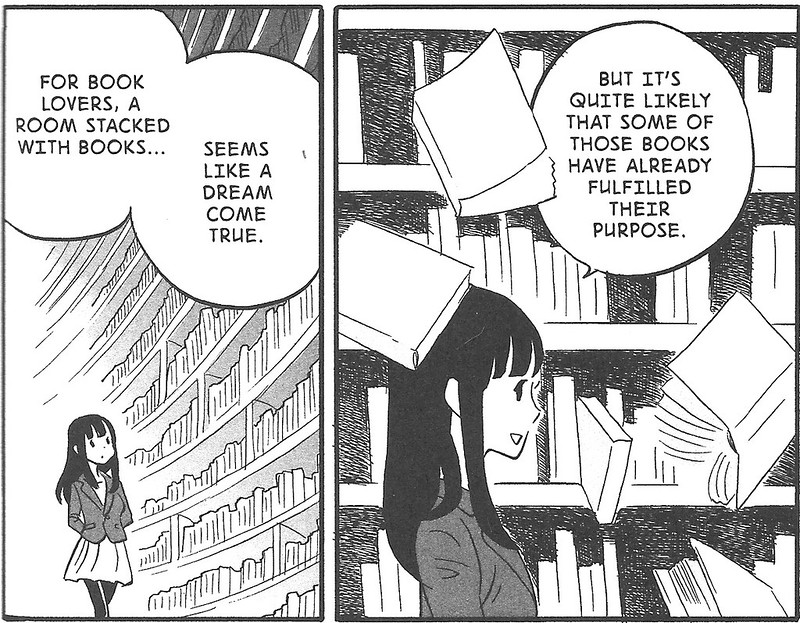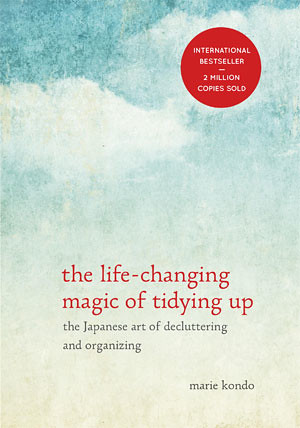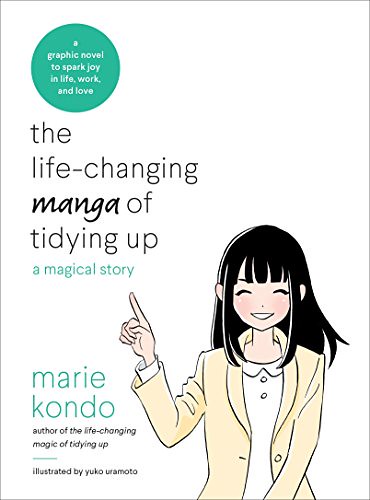Because I’m a money nerd and a comics nerd, one of my favorite things is when these two obsessions come together in the form of (drom roll, please): financial graphic novels!
You might think that’s a niche I just invented, but you’d be wrong. I’ll admit that financial graphic novels aren’t common, but they are out there. I’ve written before about the comics adaptation of Studs Terkel’s Working, for instance. But I also own comic book versions of Think and Grow Rich, The Long Tail, The Alchemist, and Robert Caldini’s Influence.
My dream project? Collaborating with an artist to create a visual version of my A Brief Guide to Financial Freedom.
Imagine how happy I was last week when I stumbled upon The Life-Changing Manga of Tidying Up, the graphic-novel adaptation of Marie Kondo’s hugely popular (and hugely awesome) book on cleaning and organization. I loved The Life-Changing Magic of Tidying Up when it first came out; I love the comics version even better.
In case you’ve been living under a rock, Kondo’s thesis is that you should only own things that “spark joy” in your life. Naturally, not everything can spark joy. (Does anyone really get pleasure from their toothbrush or their coat hangers?) But to the extent possible, you should strive to only possess things that give you pleasure.
Let’s take a quick look at the KonMari method — and why it’s proved to be popular with so many people (including me).
The KonMari Method
Marie Kondo is obsessed. She’s a clean freak. Ever since she was a little girl, her passion has been cleaning and organizing. She loves to de-clutter. And because she’s Japanese, her obsession is tinged with elegance and beauty. Here’s a taste:
An avid fan of home and lifestyle magazines since kindergarten, I would read a feature on how to put things away and have to try out each suggestion immediately. I made drawers out of tissue boxes and broke my piggybank to purchase nifty storage items. In junior high on my way home from school, I would drop in at a DIY store or browse at a magazine stand to check out the latest products.
As I say, she’s obsessed. In fact, some of her anecdotes are almost alarming.
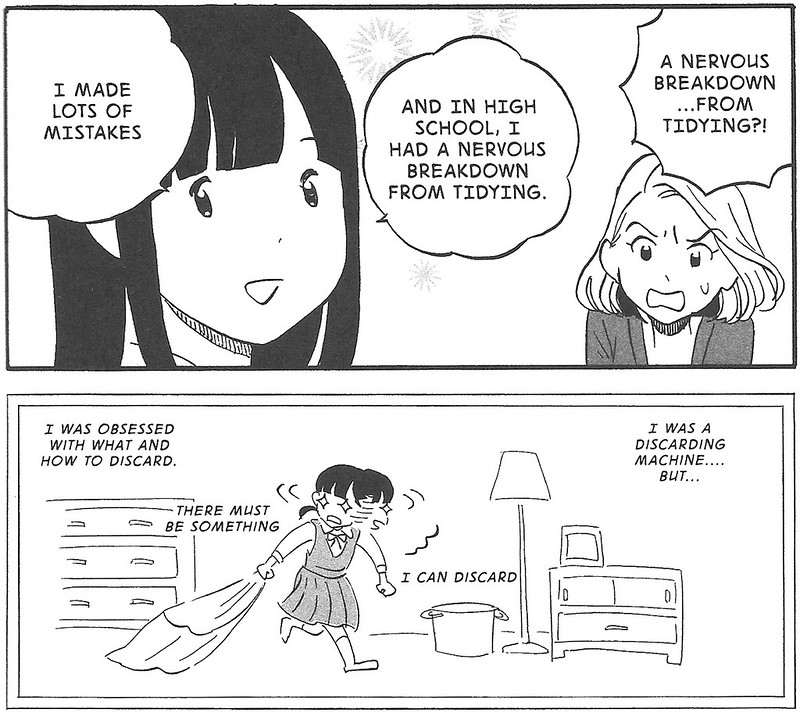
The Life-Changing Magic of Tidying Up is a fun book, but its core concepts could easily be conveyed in a magazine article — or a blog post (like this one). In fact, the concept is better conveyed in a graphic novel than in a regular book! (Apparently, I’m not the only one who thinks so. The book gets high marks on Amazon, but the graphic novel has a perfect five-star rating.)
Just as I believe money management is a psychological issue rather than a logical one, so Kondo feels about cleaning. “Success in tidying depends 90 percent on your mindset,” she writes.
It’s not enough for a space to be tidy. “Putting things away creates the illusion that the clutter problem has been solved,” she writes. But storage is not the answer. The problem persists so long as you have too much Stuff. Kondo claims the real key is to discard as much as possible.

Here are the key components of the Konmari method:
- Start by visualizing your ideal lifestyle. Think about how you really want to live. What would your home look like? What kind of life would you lead there? (This is similar to how I ask people to think about their purpose in life before setting financial goals.)
- Tidy in one large push rather than a little at a time. Gradual tidying doesn’t solve anything. When you clean in one fell swoop, it’s like hitting the reset switch on life.
- Start by discarding, all at once, intensely and completely. “Do not even think of putting your things away until you have finished the process of discarding,” Kondo admonishes. If you start putting things away before you’ve finished purging, you run the risk of getting distracted. Plus, it’s only after you’ve pared down your possessions that you can decide how to best store them in your space.
- Keep only those things that “spark joy”. This is the key to Kondo’s philosophy. She says that we ought only own things that make us happy. Most advice on de-cluttering focuses on whether items are used or useful. But Kondo argues that this sort of thinking leads us to choose what to get rid of rather than what to keep, and that’s backward. She wants readers to handle every item and ask, “Does this spark joy?” She writes: “Keep only those things that speak to your heart. Then take the plunge and discard all the rest.” Sounds lame, right? In reality, the advice is surprisingly effective.
- Tidy by category, not by location. “Tidying by location is a fatal mistake,” writes Kondo. Instead of cleaning one drawer or one room at a time, instead tackle one type of item at a time. She even recommends a specific order. “The best sequence is this: clothes first, then books, papers, komono (miscellany), and lastly, mementos…Sticking to this sequence sharpens our intuitive sense of what items spark joy inside us.”
- Don’t let your family participate. Tidy on your own. Don’t consult with your partner, your parents, or your children. Doing so will only cloud things. Work on your own.
- Once you’ve finished discarding things — and by this, she means selling them, donating them, giving them away, or putting them in the trash — only then is it okay to store them. Even then, Kondo aims for joy. She wants readers to “store your things to make your life shine”. Follow the old adage, “A place for everything, and everything in its place.” That may mean changing some of your habits. In particular, Kondo recommends storing things standing upright rather than flat whenever possible.
- Forget about “flow planning” and “frequency of use”. Kondo says that most organizational systems are based around how often things are used or how convenient it is to retrieve them. This is a mistake. If you need something, you’ll find it and pull it out. It’s much more important to make things easy to put away. She writes: “Clutter is caused by a failure to return things to where they belong. Therefore, storage should reduce the effort needed to put things away, not the effort to get them out.”
- Eliminate visual clutter. I’ve always admired the Japanese aesthetic, and a large part of that is how clean everything is. No surprise then that Kondo applies this ideal to de-cluttering. Her advice: “By eliminating excess visual information that doesn’t inspire joy, you can make your space much more peaceful and comfortable.” Only display belongings you appreciate. Don’t clutter your shelves and floorspace with knick knacks and notes and piles and so on. Keep things neat and clean.
Perhaps that all seems overwhelming. It’s not — or it shouldn’t be. It all boils down to this: Start by discarding. Keep only those things that “spark joy”. Work first with clothes, then books, papers, miscellaneous, and lastly, mementos. After purging, organize your space for maximum efficiency (and minimal visual clutter). Do this all at once rather than incrementally.
You’ve finished the process when everything is in its place.
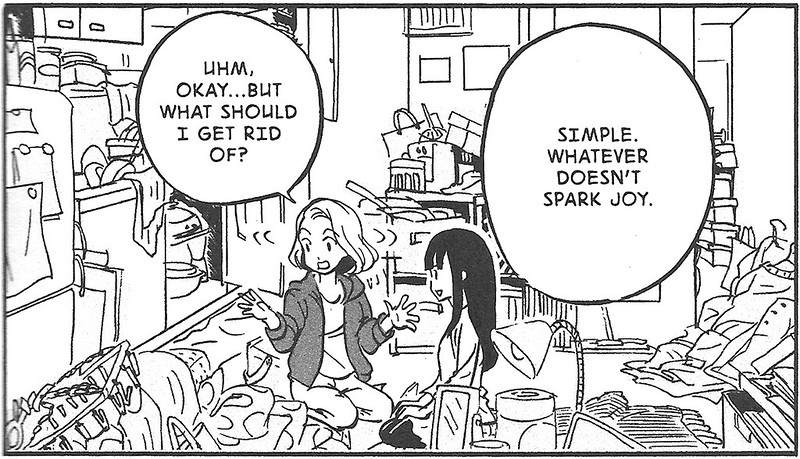
Putting Theory into Practice
So, how effective is the KonMari method? From my experience, it’s awesome. Seriously. When I stick to it, my life is less cluttered and my mind is freer.
In January 2015, I spent an entire weekend applying the Konmari method to my belongings. The results were amazing! After three days of solid work, my Stuff was organized in a neat, efficient manner. I’d managed to get rid of (almost) anything that didn’t spark joy.
The best part was that I’ve managed to maintain most of this orderliness.
Most of it.
Last weekend, after reading the graphic novel version of the Konmari method, I decided to make another pass at my Stuff.
I spent my Saturday applying Kondo’s ideas to my clothes closet and my dresser drawers. It took me three hours, but after I was finished I’d eliminated a couple boxes of clothes and drastically reduced the space I needed to store the stuff I kept.
I’m particularly pleased with how much I can fit into my dresser drawers after re-familiarizing myself with the best way to fold shirts, socks, and — gasp! — underwear. (I’ve always mocked people who fold their underwear. I’m one of those folks now.)
Look at this beautiful image:
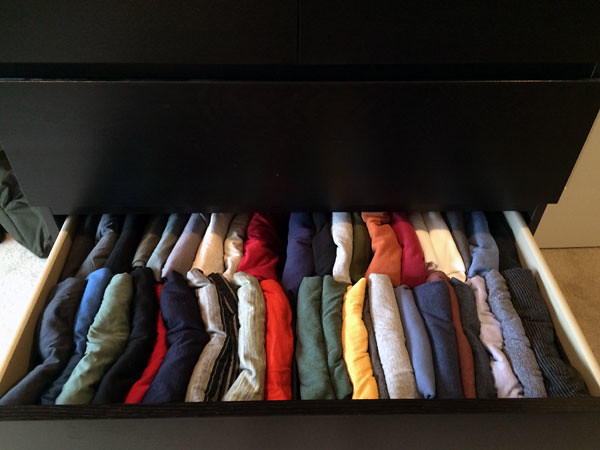
I used to store my t-shirts in two messy, mounded drawers (one for cotton, one for wool). Now all of my t-shirts fit into a single drawer — and it’s easy to tell what’s what. Similarly, my sock and underwear drawers used to be disasters. Now it’s quick and easy to find what I want.
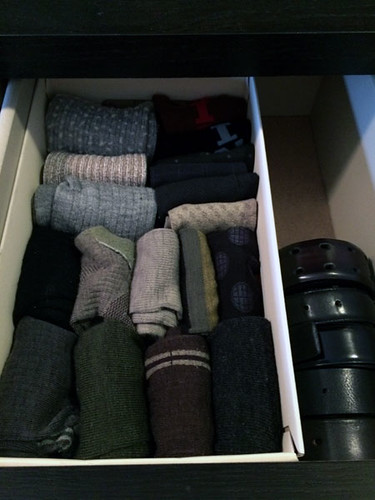

It does take a bit more time to fold things properly, but I’m okay with that. Actually, I think it’s kind of fun to fold my clothes into tiny, tidy packages.
After sorting my clothes on Saturday, I spent four hours discarding and organizing books on Sunday. Then I moved on to records and DVDs and compact discs. When I’d finished, I’d packed my Mini Cooper with stuff to sell and donate.
This coming weekend, I’m going to apply the Konmari method to my writing studio. It may sound nerdy, but I’m looking forward to it!
Conclusion
Long-time readers know that I’ve been on a decade-long quest to combat clutter. Back when I was a spendthrift, I bought a lot of Stuff. When Kris and I were together, our house and garage and workshop were packed to the gills with Stuff. Even while we were married, I started the process of purging.
Now, after having traveled extensively with nothing more than a backpack — and after having spent fifteen months exploring the U.S. by RV — I’m even more motivated to get rid of the things I no longer want or need. It seems like Kim and I are constantly purging.
The KonMari method is an excellent tool (or system, if you prefer) to help combat clutter. I’m a fan. I liked it when I first tried it in January 2015. I like it even more now.
The Life-Changing Magic of Tidying Up isn’t for everyone. If you’re naturally clean and tidy, there’s nothing new here. If Kondo’s “keep things that spark joy” message causes you to roll your eyes, you won’t have patience for this book. But I think that most folks could profit from putting the Japanese art of decluttering and organizing into practice.
